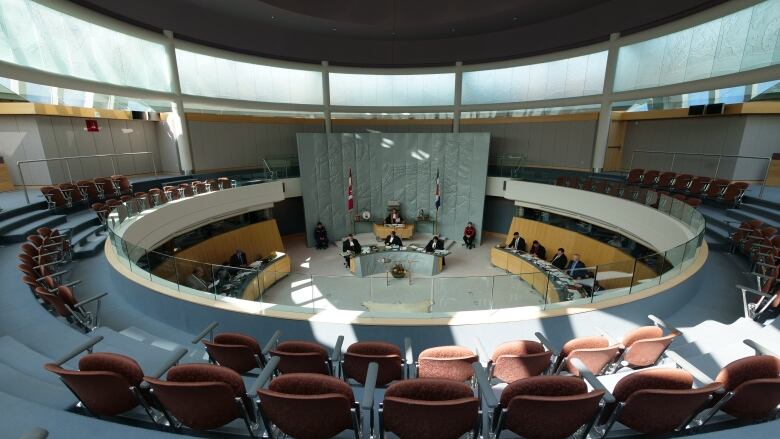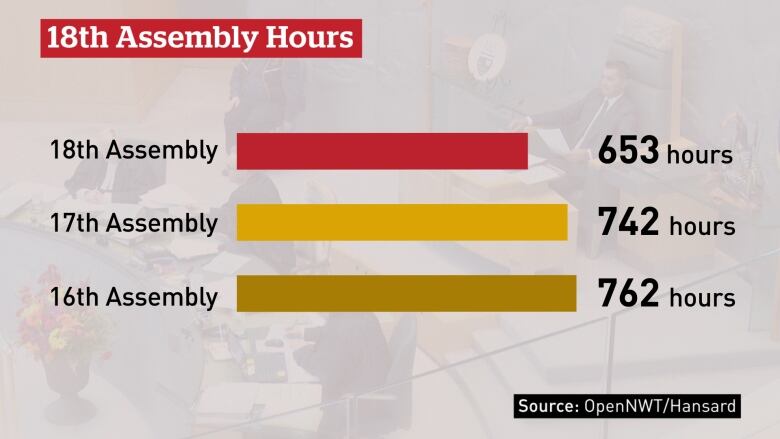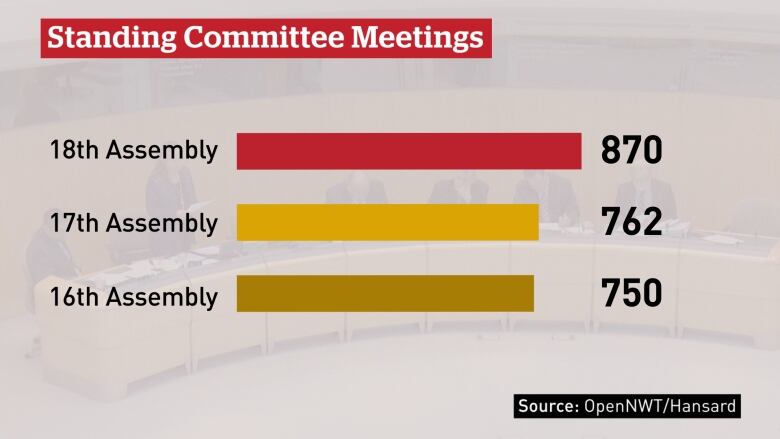The 18th Assembly did a lot, but did it differently, numbers show
OpenNWT's David Wasylciw crunches the numbers on the previous gov't prior to Oct. 1 election

Editor's note: As part of our 2019 N.W.T. election coverage, David Wasylciw, data geek and founder of OpenNWT, is taking a look at the last Legislative Assembly breaking downwhat the numberstell us about how our government and our politicians work. Most importantly, he explains what this means for you, the voter, ahead of the election on Oct. 1.
In his first instalment, David looks at how much time the government spent in the legislature, and how that timewas used.
Is my MLA effective? Or, even more simply, what did my MLA do for the last four years?
These are questions voters often ask themselves, or at the very least ask themselves in the lead-up to an election.
In a world of words, data is a powerful tool we can use to hold them accountable, but it also creates challenges. Before we dive into the numbers, let's be clear there is no single measure or metric for what makes an effective Member of the Legislative Assembly (MLA).
Some MLAs have a focus on working with residents in their constituencies, others spend more time in committee meetings and the House developing legislation. MLAs living in Yellowknife might have an easier time attending committee meetings since less travel is involved, whereas MLAs that live further away have to balance time in their ridings with time in the legislature.
Beyond even those differences, the premier, cabinet ministers and the Speaker have a whole other level of responsibility that changes the way they do their jobs. Since there is no single or perfect measure, we are going to take a number of different stats as an overview, comparing them to previous assemblies.
Each of these measures focuses on a different part of the job that our MLAs do. First, the most visible part of the job: days in session.
How long have they been sitting?
The sessional calendar stays pretty similar year-to-year, depending on priorities and bills to consider. Since 1992, MLAs have spent 1,299 days in session, an average of about 46 days per year.
The 18th Assembly sat for a total of 176 days, an average of44 days a year. For contrast, the 17th Assembly sat for 182 days, and the 16th Assembly sat for 191 days.
But the number of days in the Assembly is only part of the measure. Let's take it a step further.
We examined each day's Hansard (the record of discussion in the Assembly) for the start and end time of the day, giving us a total time spent in session. Over those 176 days, the 18th Assembly sat for a total of 652.5 hours, whereas the 16th and 17th Assemblies sat for a total of 742.25 hours and 762 hours, respectively. That's quite a few more hours.

Using time is one measure, but perhaps not the most accurate way to measure effectiveness. As most of us know, tasks have a habit of taking as much, or as little, time as we have.
Knowing that, and not wanting to encourage the next crop of MLAs to sit longer just to use up more time, we can look at what they were doing with that time.
The most obvious measure of what happens in the Assembly is the number of bills introduced and passed. In brief, the process generally works like this:
Cabinet and regular MLAs work together to develop legislation, regular MLAs study it, and it goes out for public comment. Then, MLAs work together to develop any necessary changes and the final bill is passed.
In the 18th Assembly, 94 bills were introduced and92 bills were passed.
However, once again the 16th and 17th Assemblies passed a few more. The 16th Assembly saw 107 bills introduced and 104 eventually passed, and the 17th Assembly saw 122 bills introduced, with 121 becoming law.

Fewer bills, but many more votes
Bills aren't the only thing that causes a vote in the assembly, though. There are many other reasons for MLAs to vote on any given day, including separate motions, adopting reports, changing the sitting hours, or special acknowledgements.
On these measures, the 18th Assembly has been in overdrive.
Overall in the 18th Assembly there were 402 session votes, with 395 carried (or passed). This is considerably more than the last two assemblies.
The 16th Assembly had a total of 211 votes, with 207 passed, and the 17th Assembly had a total of 252 votes, with 244 passed.

Committee meetings count, too
Session days are a big part of what MLAs do, but there's also a lot that happens behind the scenes. Standing committees of the Assembly meet on a regular basis to discuss bills, legislative proposals, hold public meetings, or hear briefings on government programs. Some of these meetings are public while many are held "in camera" confidentially.
There's no information available on how long the meetings were, but we know how many were held.
In total, the 18th Assembly held 870 standing committee and Board of Management meetings. Some of these meetings would have been only an hour, while others could have taken place over several days.
While it's difficult to tell these meetings' content or length, it's clear that the 18th Assembly held more meetings than previous Assemblies, with the 16th Assembly having held 750, and the 17th Assembly having held 762.

So, what does all this mean? Throughout the 18th Assembly, there were many instances of MLAs saying thatthey were doing a lot, and that they didn't have enough legislation to show for it. The numbers seem to agree. It's clear through the data that the 18th Assembly spent a little less time in session, but more time holding standing committee meetings.
Does this mean MLAs of the 18th Assembly were or weren't effective?
Well, it's not as easy as that. What the data shows here is that outgoing MLAsspent their four years doing things a bit differently than previous assemblies.












_(720p).jpg)


 OFFICIAL HD MUSIC VIDEO.jpg)
.jpg)



























































































